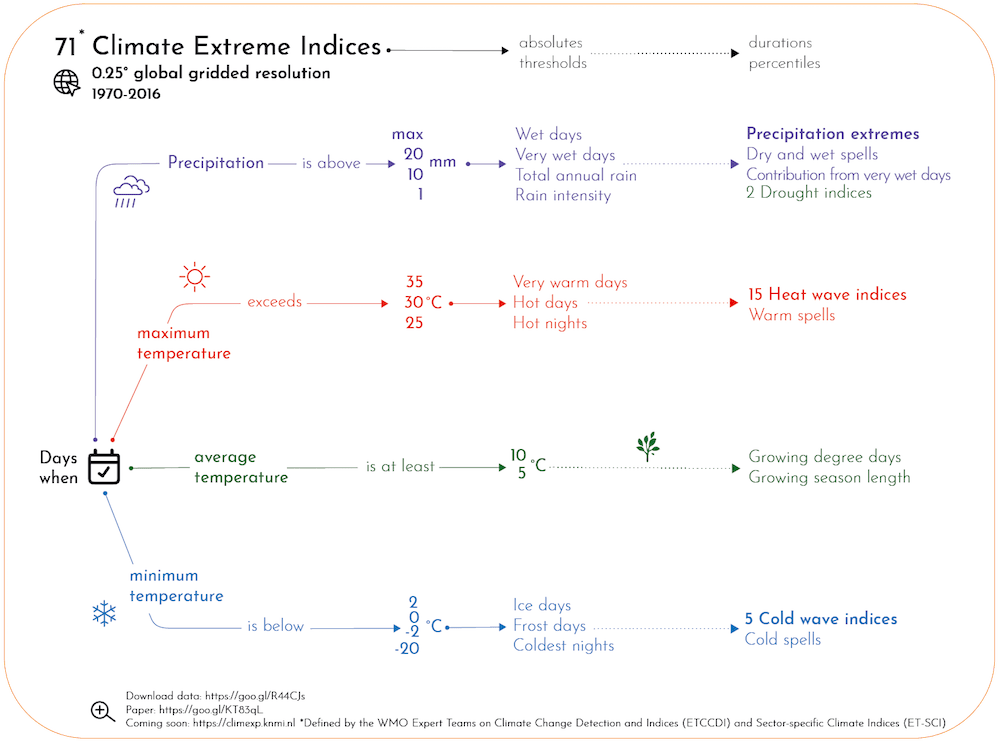
Heat wave indices, cold wave indices, precipitation extremes, drought indices and much more: climate extreme indices are important metrics that not only facilitate the analysis of regional and global extremes in meteorological events, but also aid climate modellers and policymakers in the assessment of sectoral impacts.
Now an open access dataset of 71 high-resolution global Climate Extreme Indices (CEIs) covering the period 1970-2016 has been released in a study realized in the framework of the project ENERGYA, with the contribution of Malcolm Mistry, researcher at Ca’ Foscari Department of Economics and CMCC ECIP – Economic analysis of Climate Impacts and Policy Division. The dataset just released and presented in this study is the first of its kind for the high spatial resolution (~ 25 x 25 km global grid) covering a long historical time-series (47 years). The CEIs presented in this study fill gaps in existing datasets by encompassing not only more indices, but also by being the only comprehensive global gridded CEIs available at high spatial resolution, with potential applications in key multiple sectors. For the benefit of climate research community, the dataset will be kept updated in coming years, thus making available a consistent homogenous long time-series of multiple extreme indices based on reanalysis data.
 [Figure: an overview of the dataset – click to enlarge]
[Figure: an overview of the dataset – click to enlarge]
The dataset is based on a new generation quality controlled reanalysis data product Global Land Data Assimilation System (GLDAS) developed jointly by the NASA-Goddard Space Flight Center (GSFC) and National Centers for Enviornmental Predictions (NCEP).
All indices are computed using daily near surface meteorological variables from GLDAS, namely maximum and minimum temperature (deg C), and precipitation (mm/day). In particular, the indices are tailored to be representative of droughts, precipitation extremes, heatwaves and coldwaves; characterizing both spells and durations, as well as magnitude and intensity.
More in detail, warm/very warm days, hot days/nights and warm spells have been computed in addition to 15 heat wave indices. Ice days, frost days, coldest nights and cold spells have been computed in addition to 5 cold wave indices. Dry, wet, and very wet days have been computed as precipitation extremes. Two drought indices (SPEI/SPI) at multiple (3, 6, 12, 24, 36 and 48 monthly) timescales, and growing degree days / crop growing season length are also included for the benefit of the agricultural impacts community.
While the CEIs are primarily defined, and recommended by the World Meteorological Organization Expert Teams (ETCCDI/ET-SCI) for use in sectoral impacts assessment, the indices can also be used to identify hot spots, e.g. clusters of regions showing similar historical trends in extremes, or regions with high vulnerability to extreme weather events.
Citation: Mistry, Malcolm Noshir (2019): A High-Resolution (0.25 degree) Historical Global Gridded Dataset of Climate Extreme Indices (1970-2016) using GLDAS data. PANGAEA, https://doi.org/10.1594/PANGAEA.898014, Supplement to: Mistry, MN (2019): A high resolution global gridded historical dataset of climate extreme indices. Data, 4(1), https://doi.org/10.3390/data4010041
The dataset will be mirrored on KNMI Climate Explorer, a popular one-stop shop for researchers to search, download, subset, visualize and analyze climate data. This will enable the research community (especially those focusing on regional impacts), to select only the desired spatio-temporal subset of the huge dataset available in the commonly used NetCDF-4 file format.
ENERGYA – ENERGY use for Adaptation is a project funded by the European Commission, DG Research – H2020 ERC Starting Grant focused on climate change, energy and adaption, and in particular on how people can use energy and energy services to adapt to evolving climate risks hosted at Ca’ Foscari Department of Economics. The CMCC Foundation is involved in the project with: Enrica De Cian, Associate Professor at Ca’ Foscari Department of Economics and researcher at CMCC ECIP Division, ENERGYA Principal Investigator, Marinella Davide (Ca’ Foscari Department of Economics and CMCC ECIP Division), Lorenza Campagnolo (Ca’ Foscari Department of Economics and CMCC ECIP Division) and Malcolm Mistry (Ca’ Foscari Department of Economics and CMCC ECIP Division). Read more.
In brief:
- Read the indices description: https://www.mdpi.com/2306-5729/4/1/41/s1
- Read the paper: https://doi.org/10.3390/data401004
- Download the whole dataset: https://doi.org/10.1594/PANGAEA.898014
- Browse, visualize and select the data on KNMI climate explorer


